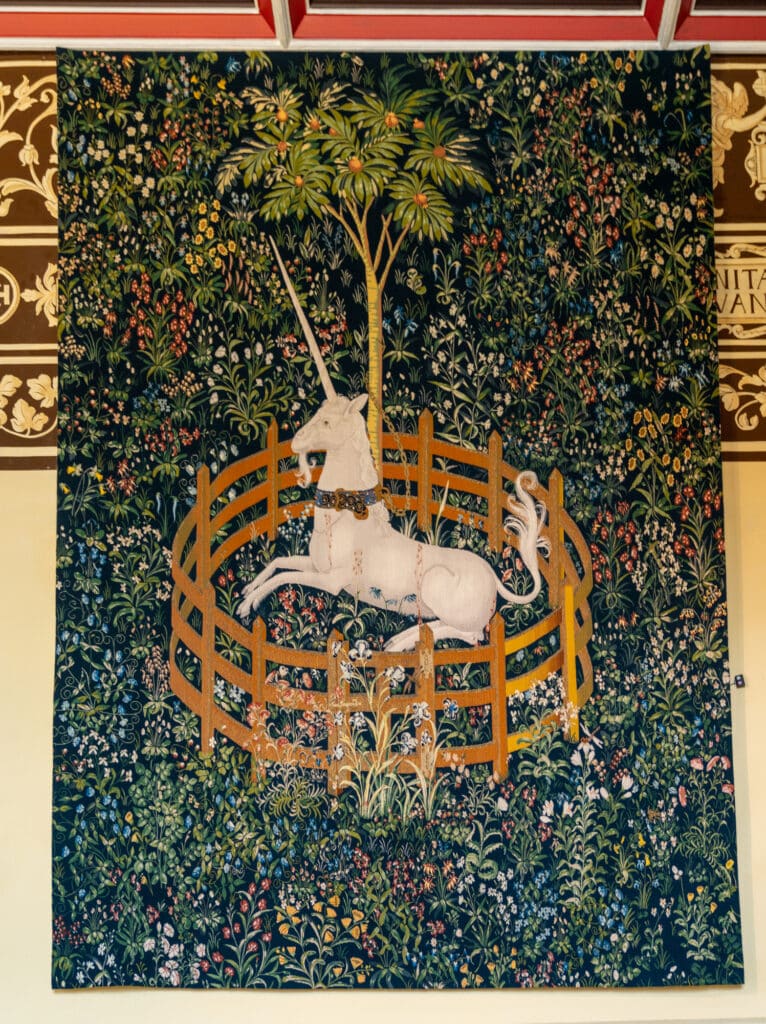We mentioned the beauty of wall hangings and their practical uses in an earlier post. Here we would like to highlight one of the most beautiful and mysterious tapestries ever created: The Hunt of the Unicorn. This is a series of seven tapestries, and their origin dates from between 1495 and 1505. In its entirety, it’s considered to be one of the greatest artworks in existence. Despite it fame, many mysteries persist about The Hunt of the Unicorn, including who designed it, where it was woven, and what its panels are intended to symbolise.
Woven with wool, silk, and metallic thread, there are 5 large pieces, one small piece, and one piece that survives only in fragments. Each large tapestry is 12 feet tall by 14 feet wide. The seven tapestries are:
- The Start of the Hunt
- The Unicorn at the Fountain
- The Unicorn Attacked
- The Unicorn Defending Himself
- The Unicorn is captured by the Virgin (in two fragments)
- The Unicorn Killed and Brought to the Castle
- The Unicorn in Captivity
Together, the tapestries tell a tale of noblemen who, with their huntsmen and hounds, pursue a unicorn through a beautiful forest. They track down the unicorn, capture it, take it to a castle, and kill it. In the final tapestry the unicorn is resurrected and shown resting in a garden enclosed by a circular fence.
Unicorns are, of course, magical, pure creatures, and unicorn lore was popular in the medieval period when the tapestry was made. They represented wisdom, immortality, lovers, and marriage. People believed that unicorns could heal wounds and purify water and that only a virgin could tame a unicorn. These themes are woven into the individual tapestries of The Hunt of the Unicorn. A virgin leads the unicorn into an enclosed rose garden where it is sacrificed.
There is entirely another meaning to these tapestries, however. The unicorn at the center of The Hunt of the Unicorn is also clearly meant to represent Jesus Christ, and the virgin is meant to be his mother, Mary. There are many clues hidden within images of the tapestries to indicate this. The unicorn is wounded on his right side, as was Christ. The unicorn is sacrificed and resurrected. In the final tapestry the unicorn sits in a beautiful garden paradise. The piece as a whole was clearly designed to be meaningful and relevant on two levels: both secular and religious. The people of this age would have understood both messages.
Scholars believe that The Hunt of the Unicorn was of French design and woven in Brussels, but more than that is unknown. The initials AE appear over and over in the tapestries, but who AE was, if AE was a person, is another mystery. For centuries they were owned by the La Rochefoucauld family of France. John D. Rockefeller purchased most of the set in 1922 and displayed them in his own house until he donated them to the Metropolitan Museum of Art in 1938 along with the missing pieces he had tracked down. The Met has housed The Hunt of the Unicorn since then in the Cloisters where they are on permanent display for the public to view (above image theirs).
The Hunt of the Unicorn shows the intersection of art and everyday objects, of the sacred and the secular in a very beautiful way. It’s art that serves as more than art, but a reminder of the Easter message as well.


